NASA’s Deputy Administrator Dava Newman has a vision for the future of humankind on Mars and on earth. She advocates for an inclusive approach to garner top talent for math, science, art and design fields encompassed in STEAMD programs—and thinks that understanding engineering as an integrated field for problem solving will ultimately serve the industry best.
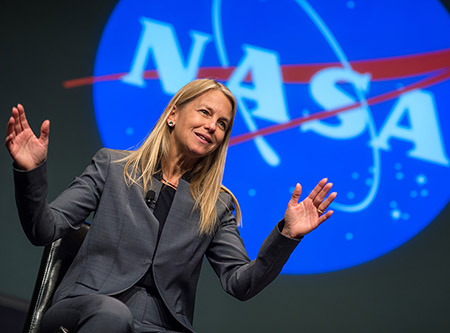
NASA’s new Deputy Administrator Dava Newman is seen during a NASA town hall meeting where she and NASA Administrator Charlie Bolden talked with employees, Tuesday, May 19, 2015 at NASA Headquarters in Washington. Photo Credit: (NASA/Bill Ingalls)
When you first meet Dava Newman, it’s easy to warm to her friendly and comfortable manner. But make no mistake about it, she’s also focused and eager to get to work—qualities that have served her well as NASA’s second in command. Newman, who holds a Ph.D. in aerospace biomedical engineering from MIT, has served the space agency for a year and a half as Deputy Administrator, and has led projects as diverse as Mars exploration and organizational innovation.
As engineers and scientists move into more leadership roles to manage both technical and non-technical people, Newman sees a lot of opportunity. “As engineers, we’re at our best when working with people who aren’t exactly like us,” she said. Her logic is that engineers lend intellectual diversity when working as part of a team, especially when they bring depth of technical knowledge on a subject.
“There’s no substitute for understanding other disciplines,” she said, noting that written communications, oral communications, and visual communications are all key for today’s engineers. The latter includes graphic design, animation, technical illustration, industrial design, and software-based forms of distilling and presenting data and ideas, and is where Newman sees most room for improvement for those in technical fields.
“We technical types need to start working on visual communications skills, because that’s not usually taught in school. I certainly wasn’t taught that, so I’m trying to make up for it. We also want the future workforce to be on top of their game in this department. We want them to be incredibly good communicators, especially as we’re quantitative people.” These days, much of sharing quantitative information depends on leveraging all modes of communication.
As her career path attests, Newman herself is an excellent communicator and knows how to get her message out. She says her secret is practice, practice, practice. 25 years of being a college professor certainly involved a lot of talking for Newman, but it often took the form of 90-minute lectures. Her role now requires that she give many shorter speeches each day.
“I’ve learned a lot here at NASA about communicating on a different level,” she said. “It’s been really interesting and a great experience for me.”
Leaders and managers
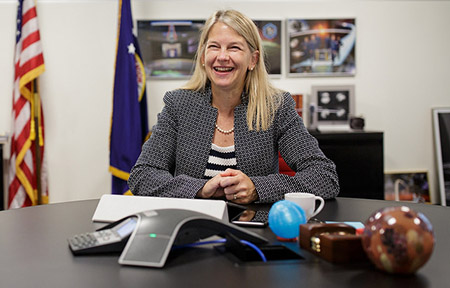
NASA Deputy Administrator Dava Newman speaks by phone with NASA astronaut Kate Rubins about her upcoming mission to the International Space Station, Friday, July 1, 2016 at NASA Headquarters in Washington, DC. Photo Credit: (NASA/Joel Kowsky)
Newman sees leaders as separate from management, and is quick to contrast the roles.
“I think they’re both incredibly valuable functions. The truth is that leaders can manage, and some managers must also lead, but it’s useful to differentiate these responsibilities. After all, leading doesn’t just mean just leading from the front. Usually it’s more distributed leadership through consensus building and having and sharing a vision. In my opinion, leadership starts with vision and putting that in context by making sense of the goal’s real-world environment. Case in point: At NASA we have the vision and are on a clear journey with a goal to get people to Mars in the 2030s.”
As most champions in industry, Newman stresses that good leadership and management puts one’s teammates first. “First and foremost is relating to people and asking, ‘What about our people?’ That’s why it’s a pleasure and an honor for me to work with [NASA Administrator] Charlie Bolden, because he says in every speech he gives every day that it’s about taking care of our people. Members of any team must be very, very highly valued, and they have to know they’re valued; we’re really sincere about it.”
Just last month, NASA was named the best place to work in the federal government for the fifth consecutive year. The annual survey of federal workers is published by the Partnership for Public Service and ranks almost 400 federal organizations by overall employee satisfaction and commitment. Additionally, it evaluates key workplace focus areas, including innovation, training and development, leadership and diversity.
“We’re lucky because we get the best and brightest to come join us at NASA,” Newman said. “There’s also diversity because some specialize in research, some in aeronautics, some in space, and some in the sciences.”
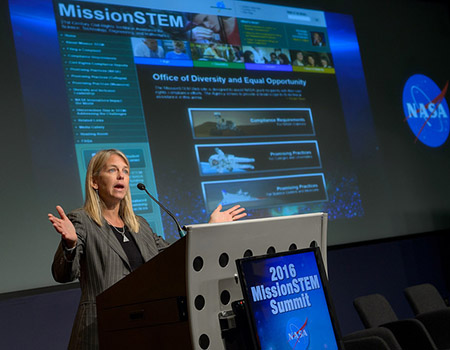
NASA Deputy Administrator Dava Newman delivers remarks during the MissionSTEM Summit 2016, Monday, Aug. 8, 2016 at NASA Headquarters in Washington. Photo Credit: (NASA/Bill Ingalls)
Turning STEM into STEAMD
There’s been a long national discussion about science, technology, engineering and math (STEM) education and careers. Newman wants to jump headfirst into the conversation—but to change it with the addition of a couple of letters for art and design.
“I love STEM—my entire career has been what can we do to improve the study and pursuit of science and technology, engineering, and math. But I’d change the conversation and call it STEAMD, because it’s always been STEAMD for me. My whole career I’ve brought artists into projects because they help me with visioning, sense making, relating and inventing. Just consider Michelangelo confronted with a hunk of marble. How did he envision David? That challenges me every day: How does this beautiful thing come out of that?”
It begs the question of what Michelangelo would’ve sculpted with 21st-century tools. After all, nowhere is the convergence of art and science more pronounced than in the burgeoning uses of 3D printing.
“We have a whole generation of 3D makers, so the D for design in STEAMD is for the designers of this maker generation. If someone doesn’t see him or herself as a rocket engineer, I’m completely okay with that, and I’m not going to force them.” Such an attitude allows for crossover engineering fields in high-tech fashion and architecture not possible even a few years ago.
On the same token, Newman thinks the old engineering-school tradition of celebrating “weed-out” classes is the wrong way to approach things, whether drawing new kids into STEAMD careers or building audacious new teams at NASA.
“No more filtering anyone out. Instead we should filter everyone in and say, ‘Hey, do you want to make the impossible possible?’ Because that’s what we do, we turn dreams into reality—but we must cast a large net and filter in more candidates. I think that that’s our responsibility in the technical community. I think we really got it wrong filtering people out, and we don’t have the luxury to do that anymore,” she said.
Newman feels that another problem from the past is the idea that one must be the absolute best in every technical subject to succeed in an engineering career. She tells kids all the time that’s untrue.
“That idea of needing to be scholastically perfect is completely wrong,” she said. “So I change the conversation. You don’t need to be the best. Instead I ask students, ‘You want to be an astronaut? You want to get to Mars? You want to be the designer of the next X-plane?’ and I get a lot of kids shaking their heads yes, yes and yes. They want to solve big problems such as climate change. They also want to solve clean-water problems. That’s when I explain that this is what engineers do: We have a problem and we solve it. Then I tell these aspiring students who want to solve big problems that we need tools to do so.”
Of course, those tools are math skills and knowledge of hard sciences. “You’re going to take your math, and you’re going to take your chemistry, calculus, and physics—but concepts learned in these subjects are just tools. I remind students that they’re going to have to study hard, and yes it’s going to be challenging, of course. But I tell them to put it in perspective. They’re really after tackling big problems, and concepts learned in school are nothing more than tools they’ll use later to accomplish their ultimate goals. It’s so important that younger folks abandon the idea that they must be the best in science and math or despair if they get a B. A lot of us got plenty of Bs to go along with our As. I think that that’s important to tell aspiring scientists and engineers to keep pursuing their dreams, even if they weren’t the best student in their calculus class.”
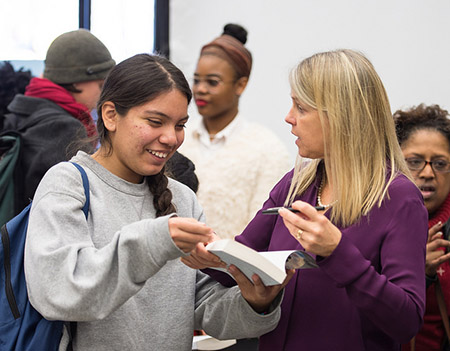
NASA Deputy Administrator Dava Newman autographs a “Hidden Figures” book at an event with author Margot Lee Shetterly, Wednesday December 14, 2016 at Martin Luther King Jr. Memorial Library in Washington. The film, based on the book, chronicles the lives of Katherine Johnson, Dorothy Vaughan and Mary Jackson—African-American women working at NASA as “human computers,” who were critical to the success of John Glenn’s Friendship 7 mission in 1962. Photo Credit: (NASA/Aubrey Gemignani)
Getting young women STEAMD
Newman acknowledged that there’s unconscious bias in many places where females are in a classroom setting in subjects that have historically been male dominated.
“Unfortunately it’s there, so I think it’s good to acknowledge it. I guess I had a lot of passion to make it in aerospace, so I tried to never let the discouragement affect me too much. I think being a competitive athlete really helped, because again, I wanted to excel. I always tell folks if they hear discouragement, just don’t listen. Saying no is the easiest thing in the world—saying yes, this is how you succeed. Then I say yes, this is how you can be great. I’m a big fan of just saying yes. Everyone I think has infinite talent, but we must harness that.”
She said she didn’t pay much attention to the folks who said no.
“I just thought they were small-minded, and thought: I want to fly and design and get humans to Mars. So I’ve been focused on that trajectory for many decades,” she said.
What advice does she give to young would-be female engineers?
“It is the coolest job you could ever have … and we need female engineers. I’d love them to join us. Whatever big problems and challenges they see in the world, engineering is probably for them, because we are problem solvers devising solutions—especially if they like to get their hands dirty and make and build and design things. I just want to make sure they know that, for me, I would never trade it for the world. It’s been a great career, and I can’t imagine doing anything else.”
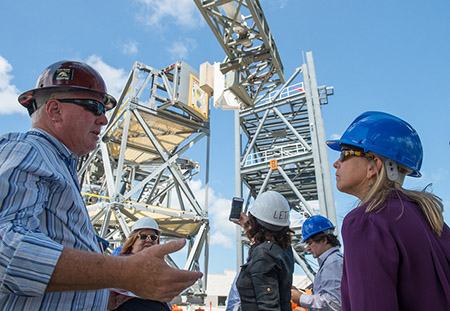
NASA Deputy Administrator Dava Newman, right, views umbilicals that will be used for NASA’s Space Launch System that are undergoing testing at the Launch Equipment Test Facility on Thursday, Sept. 8, 2016 at NASA’s Kennedy Space Center in Florida. Photo Credit: (NASA/Joel Kowsky)
Next steps
Newman acknowledged that her future as NASA was a little uncertain, due to the change of administrations.
“It’s been a pleasure to serve in the Obama administration, and it’s been incredible for me to serve NASA as the Deputy Administrator. I wouldn’t change it for the world, as it’s probably been my best job ever. Keep in mind that for me, being Apollo professor at MIT was before coming here the best job ever—to teach students and do research. How fortunate am I to have had two amazing jobs.”
She always wanted to serve in the government, so if given the opportunity she’ll likely continue the work. “Exploration is my passion, so it will definitely be this vision of getting humans to Mars, whether working at NASA or externally. My life goals and career goals all stem around exploration. In a very broad sense, it starts with the oceans, moves to Earth, our spaceship Earth, and then air and space. I really see exploration across the continuum of all those four. I will be involved hopefully, and that’s my plan for the next decade or two.”
Newman also laughed about how earlier in her career, she felt that engineers and scientists were often overlooked—but that has shifted a great deal.
“Now we’re cool and in vogue. The upside is now people expect us to lead. That’s a huge shift. Previously the perception was, ‘Well, they’re in the lab, and they’re doing their technologies, and they’re doing their robotics, and they’re doing their science.’ Now it’s wonderful because there are many technical leaders in government, industry and academia.”
Filed Under: Pneumatic Tips, Slider, Women in Fluid Power
